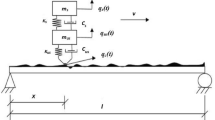Abstract
A method is developed to estimate pavement macrotexture depth (MTD), using measurements from a microphone mounted underneath a moving vehicle. The acoustic energy is assumed to have positive linear correlation with MTD of the pavement. However, the acoustic measurements will include tire-generated sound that carries information about the road features as well as noise generated by the environment and vehicle. The variations in frequency of the noise are assumed to be small compared to the variations in frequency of the signal related to road features, which allows principal component analysis (PCA) to filter noise from microphone data prior to estimating its energy over an optimally selected bandwidth. The acoustic energy computed from the first principal component (PC) is termed as PCA energy, which is an important variable for MTD prediction. The frequency band most relative to pavement macrotexture was determined to be 140–700 Hz. Then, an MTD prediction model was built based on a Taylor series expansion with two variables, PCA energy and driving speed. The model parameters were obtained from an engineered track (interstate highway) with known MTD and then applied to urban roads for the feasibility test. The predicted MTD extends its range from 0.4–1.5 mm of the engineered track to 0.2–3 mm, which is the typical range of MTD. In addition, the excellent repeatability of the MTD prediction is demonstrated by the urban road test. Moreover, the potential to use the predicted MTD for pavement condition assessment is discussed. Therefore, the PCA Energy Method is a reliable, efficient, and cost-effective approach to predict equivalent MTD for engineering applications as an important index for pavement condition assessment.











Similar content being viewed by others
References
ISO 13473–1 (1997) Characterization of pavement texture by use of surface profiles—part 1: determination of mean profile depth, 1st edn. American National Standards Institute, Washington, DC
Stroup-Gardiner M, Brown ER (2000) Segregation in hot-mix asphalt pavements. Report no. 441, Transportation Research Board
Henry JJ (2000) Evaluation of pavement friction characteristics, vol 291. Transportation Research Board
Flintsch GW, de Leon E, McGhee K, Al-Qadi I (2003) Pavement surface macrotexture measurement and application. Transp Res Rec J Transp Res Board 1860(1):168–177
ASTM (2004) Standard test method for measuring pavement macrotexture depth using a volumetric technique. ASTM E965, West Conshohocken
ASTM (2009) Standard practice for calculating pavement macrotexture mean profile depth. ASTM E1845, West Conshohocken
Veres RE, Henry JJ, Lawther JM (1975) Use of tire noise as a measure of pavement macrotexture. In: Rose JG (ed) Symposium named Surface texture versus skidding: measurements, frictional aspects, and safety features of tire-pavement interactions. ASTM, West Conshohocken, pp 18–28
Sandberg U, Ejsmont JA (2002) Tyre/road noise reference book. Informex, Kisa
Saykin V, Zhang Y, Cao Y, Wang ML, McDaniel JG (2013) Pavement macrotexture monitoring through the sound generated by tire-pavement interaction. J Eng Mech 139(3):264–271
Zhang Y, Ma X, McDaniel JG, Wang ML (2012) Statistical analysis of acoustic measurements for assessing pavement surface condition. In: Proceedings of SPIE smart structures and materials + nondestructive evaluation and health monitoring. International Society for Optics and Photonics, Bellingham, p 83471F
Zhang Y, McDaniel J, Gregory, Wang ML (2014) Estimation of pavement macrotexture by principal component analysis of acoustic measurements. J Transp Eng 140(2):04013004-1–04013004-11
Sandberg U (2003) The multi-coincidence peak around 1000 Hz in tyre/road noise spectra. In: Euronoise Conference, paper ID, vol 498
KMS & Associates, Inc. (2007) Micro PAVER: Pavement Management System. http://www.city.pittsburgh.pa.us/district8/assets/07_pavement_mgt_system.pdf. Accessed 8 May 2013
Metro Nashville (2006) Metro Nashville long range paving plan, Chapter 3 pavement management data. http://mpw.nashville.gov/IMS/Paving/Documents/Chapter_3.pdf. Accessed 12 May 2013
Wang HQ, Song ZH, Wang H (2002) Statistical process monitoring using improved PCA with optimized sensor locations. J Process Control 12(6):735–744
Pearson K (1901) On lines and planes of closest fit to systems of points is space. Philos Mag 6(23):559–572
Hotelling H (1933) Analysis of a complex of statistical variables into principal components. J Educ Psychol 24(6):417–441
Jolliffe IT (2002) Principal component analysis, 2nd edn. Springer, New York
Greenberg MD (1998) Advanced engineering mathematics, 2nd edn. Pearson Education, India, pp 1236–1242
Dienes P (1957) The Taylor series: an introduction to the theory of functions of a complex variable. Dover Publications, New York
Roe PG, Webster DC, West G (1991) The relation between the surface texture of roads and accidents. Research report 296, Transport and Road Research Laboratory, Wokingham, UK, TRL. http://www.roadsafetyobservatory.com/Evidence/Details/10569. Accessed 6 Mar 2013
Wang ML, Birken R Shamsabadi SS (2014) Framework and implementation of a continuous network-wide health monitoring system for roadways. In: Proceedings of the SPIE 9063, nondestructive characterization for composite materials, aerospace engineering, civil infrastructure, and homeland security, Vol. 9063. California, pp 1–12
WesTrack (2001) Superpave mixture design guide. WesTrack Forensic Team consensus report. Federal Highway Administration, Washington, DC
Author information
Authors and Affiliations
Corresponding author
Rights and permissions
About this article
Cite this article
Zhang, Y., McDaniel, J.G. & Wang, M.L. Pavement macrotexture measurement using tire/road noise. J Civil Struct Health Monit 5, 253–261 (2015). https://doi.org/10.1007/s13349-015-0100-4
Received:
Revised:
Accepted:
Published:
Issue Date:
DOI: https://doi.org/10.1007/s13349-015-0100-4




